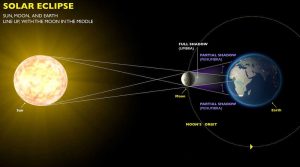
A total solar eclipse happens when the moon, the sun and the Earth all line up such that the moon completely obscures the sun to viewers on part of Earth’s surface.
DUANE SHERRILL – Contributor
While middle Tennessee won’t get the full effect of the “Ring of Fire” eclipse like the Southwestern U.S. this Saturday, the sky will dim as the moon passes between the Earth and Sun during the Oct. 14 annular eclipse.
Middle Tennessee will see 60 percent of the Sun obscured at the peak of the celestial event which will happen around 12:05 p.m. Saturday. First contact will begin at 10:38 a.m. and the overall event will end at 1:36 p.m. Total time in middle Tennessee will be two hours, 58 minutes
The “ring of fire” solar eclipse will be visible to those along a narrow path sweeping over North and South America. At mid-eclipse, those along that eclipse path will see the sun in a ring around the moon. Those outside the shadow path, like middle Tennessee, will see a partial solar eclipse. Astronomers are quick to point out that this is not a total eclipse. At no time during this eclipse will it be safe to look at the sun without proper eye protection since there will be that “ring of fire” visible even where it is close to full.
Astronomers call this an annular eclipse of the Sun. That name comes from the Latin word for ring: annulus. At maximum eclipse – for those along the eclipse path – the sun will be 0.907 percent covered by the moon. In middle Tennessee it will peak at 0.622 percent.
The part of the sun that will visible is its outer surface. The main shadow will move southeast from just south of Portland, Ore., just north of Las Vegas, Nev., cutting through Santa Fe and Albuquerque, N.M. and just south of San Antonio, Texas. It will then sweep over the Yucatan Peninsula and parts of Central America.
When watching an annular solar eclipse directly with your eyes, you must look through safe solar viewing glasses (“eclipse glasses”) or a safe handheld solar viewer at all times, according to NASA. Eclipse glasses are not regular sunglasses; regular sunglasses, no matter how dark, are not safe for viewing the Sun. Safe solar viewers are thousands of times darker and ought to comply with the ISO 12312-2 international standard. Do not look at the Sun through a camera lens, telescope, binoculars, or any other optical device while wearing eclipse glasses or using a handheld solar viewer — the concentrated solar rays will burn through the filter and cause serious eye injury.
If you don’t have eclipse glasses or a handheld solar viewer, you can use an indirect viewing method, which does not involve looking directly at the Sun. One way is to use a pinhole projector, which has a small opening (for example, a hole punched in an index card) and projects an image of the Sun onto a nearby surface. With the Sun at your back, you can then safely view the projected image. Do not look at the Sun through the pinhole.
The next annular eclipse will happen on Oct. 2, 2024, and will be visible from the Southeast Pacific and Southern America. In 2024, U.S. residents will be treated to a total solar eclipse on April 8. The narrow strip of totality for that eclipse will fall just outside Tennessee, crossing parts of Texas, Arkansas, Indiana, Kentucky and Ohio.
While location is important for viewing, so is the weather. Presently long range forecasts for the area give a 30 percent chance of rain for Saturday and predict it will be partly cloudy.
Times to watch the eclipse
First Contact: 10:38 a.m.
Peak viewing: 12:05 p.m.
End of event: 1:36 p.m.
The Marion Tribune – October 12, 2023





